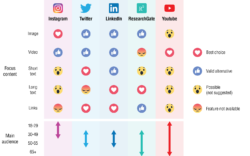To build up a personal brand and have a presence on social media is becoming a must for people interested in developing a career in academia. It helps researchers stand out and increase the visibility of their work. In CEE, a good example of this is Professor Markus Buehler. With almost 4,000 followers on his Twitter account, Prof. Buehler (@ProfBuehlerMIT) takes advantage of social media to share his group’s research, new publications and media presence, while interacting with colleagues and students. Although Twitter is not the most popular social media platform among Americans (only 27% of US adults declare that they use it in 2019 according with Pew Research Center, while 69% say they use Facebook and 73% YouTube), it is very popular among scientists and young faculty. Boya Xiong (@boyaxiong_umn), a former Postdoc in CEE and current Assistant Professor at UMN (University of Minnesota), is very active on Twitter, not only posting her work but also sharing and commenting on other colleagues’ work. This is a great way to gain visibility among peers and the general public, and in the long term, increase your research impact. José Luis Ortega (2017) observed that research papers published in journals with their own Twitter account receive 34% more citations than those without.
Those who aim to pursue a career in industry can also take advantage of social media, but in this case it is important to clearly separate our own opinions and work from the ones of our company. For entrepreneurs, presence in social media is key. Aceil Halaby (@AceilHalaby) and Alicia Chong R. (@achongr), co-founders of the MIT startup Bloomer Tech, use their Twitter accounts not only to advertise their product, but also to share real examples of empowering women in medicine and technology. They show us that building up a personal brand as a scientist, researcher or entrepreneur requires distinguishing the specific message you want to send to the public and the audience you are trying to reach. Establishing yourself on social media can increase the visibility of your work, and consequently, your impact.
Defining Your Message
When building up a personal brand, the message you transmit in social media becomes your public identity. It is the way the audience will recognize you and relate you with. Therefore, it is important to decide the message you want to transmit, which will be the defining aspect of our personal brand.
When defining your message, you will likely take inspiration from your research focus. However, you can also take the opportunity to engage with topics you’d like to start working on, outside of your current research. Social media websites are not specialized journals. You are free to choose what to share and write about. You can also shape your personal brand by identifying professional interests, whether that be a social movement or involvement in a professional group.
Identify Your Audience
Your intended audience will define which social media platform to choose. You can have multiple audiences (e.g. colleagues, investors, the public), and use different platforms to reach them. Consider the audience associated with different platforms, their expected level of expertise in your field, and level of popularity.
More popular platforms, like Facebook, Twitter and YouTube, will allow you to reach broader and more general audiences, especially if one of our posts goes viral! Alternatively, LinkedIn or ResearchGate will allow you to reach a smaller, more specific, audience, that will lead you to a different type of interaction with prospective employers, colleagues, or organizations you partner with.

Using Platforms to Target and Engage with Your Audience
Determining the type of content you want to share to communicate your message (pictures, text, video) is part of addressing the audience and will also define which platform to choose.
For this purpose, we need to clearly understand the difference between the social media platforms available out there. This would help us to decide in which of them be active. Here we summarize the most popular platforms nowadays and their main characteristics. Consider posting across multiple platforms to diversify your audience.

A few pieces of advice to get started:
- Define a clever @username to use across multiple platforms.
- Take advantage of #Hashtags, which are useful to make our content appear in searches and facilitate followers to find it.
- Post regularly and consistently. To grow our community we need to be active in social media. This means posting new content frequently.
Additional reading
Check out the full collection of free CommKit Resources created by the MIT CEE Comm Lab team.
